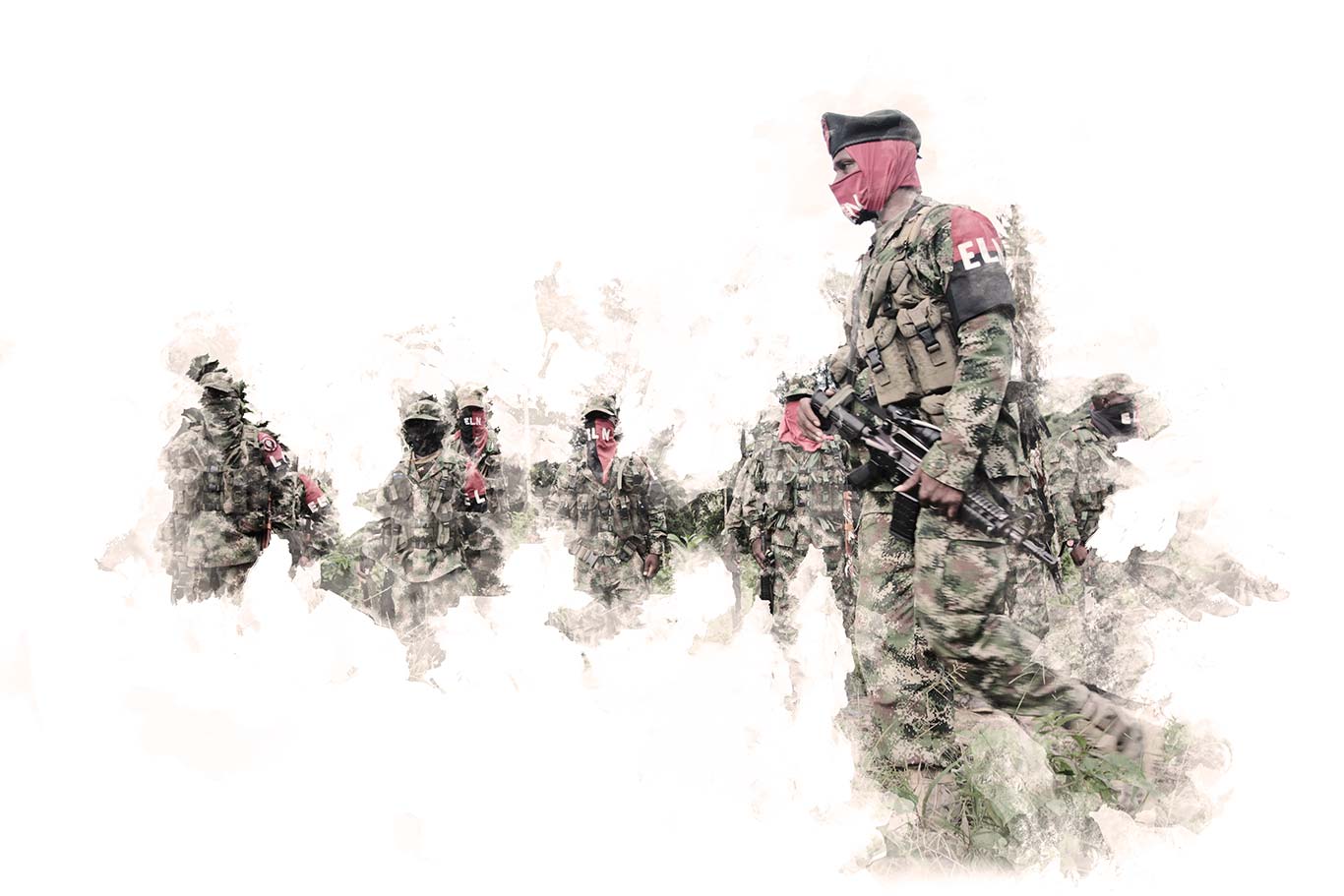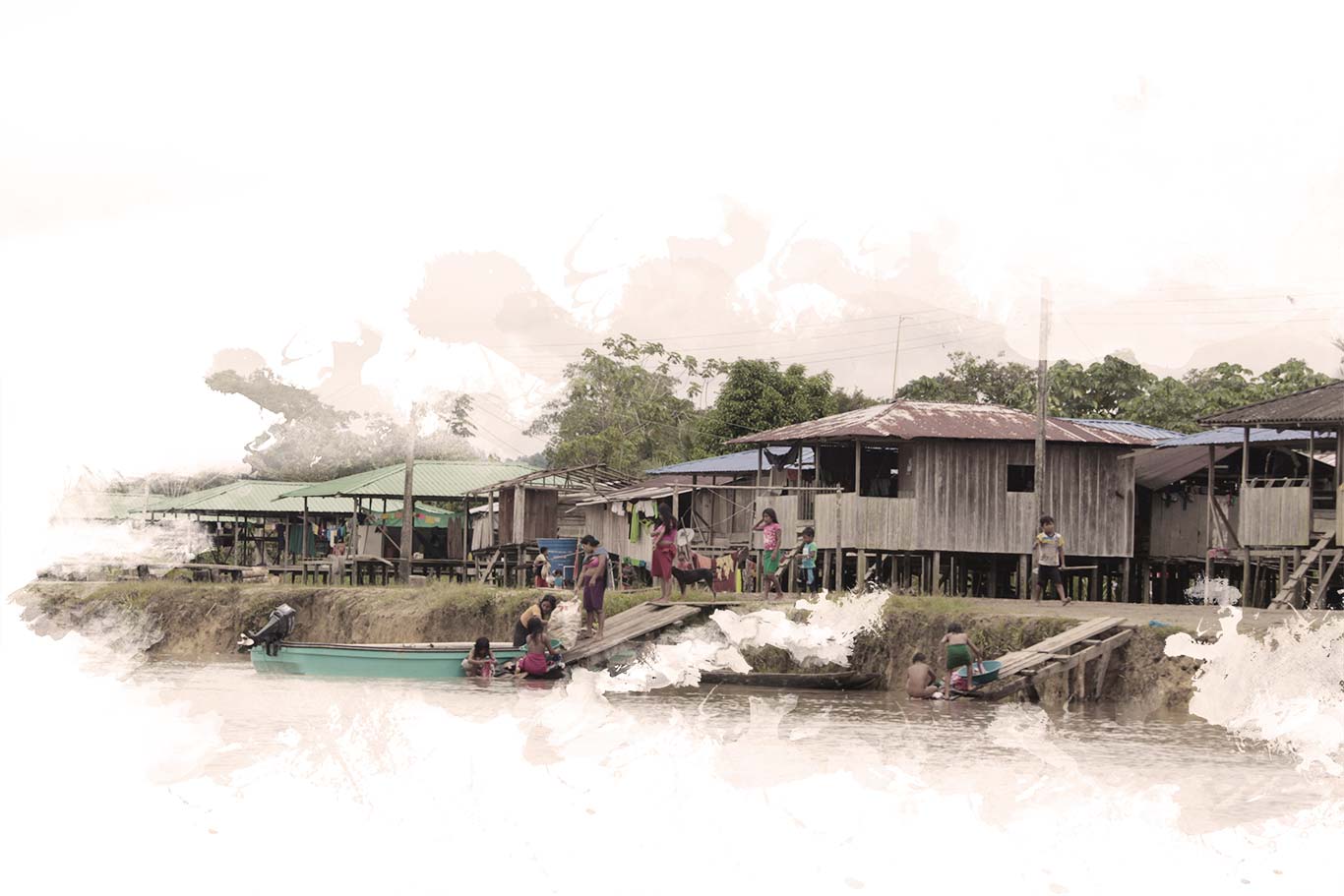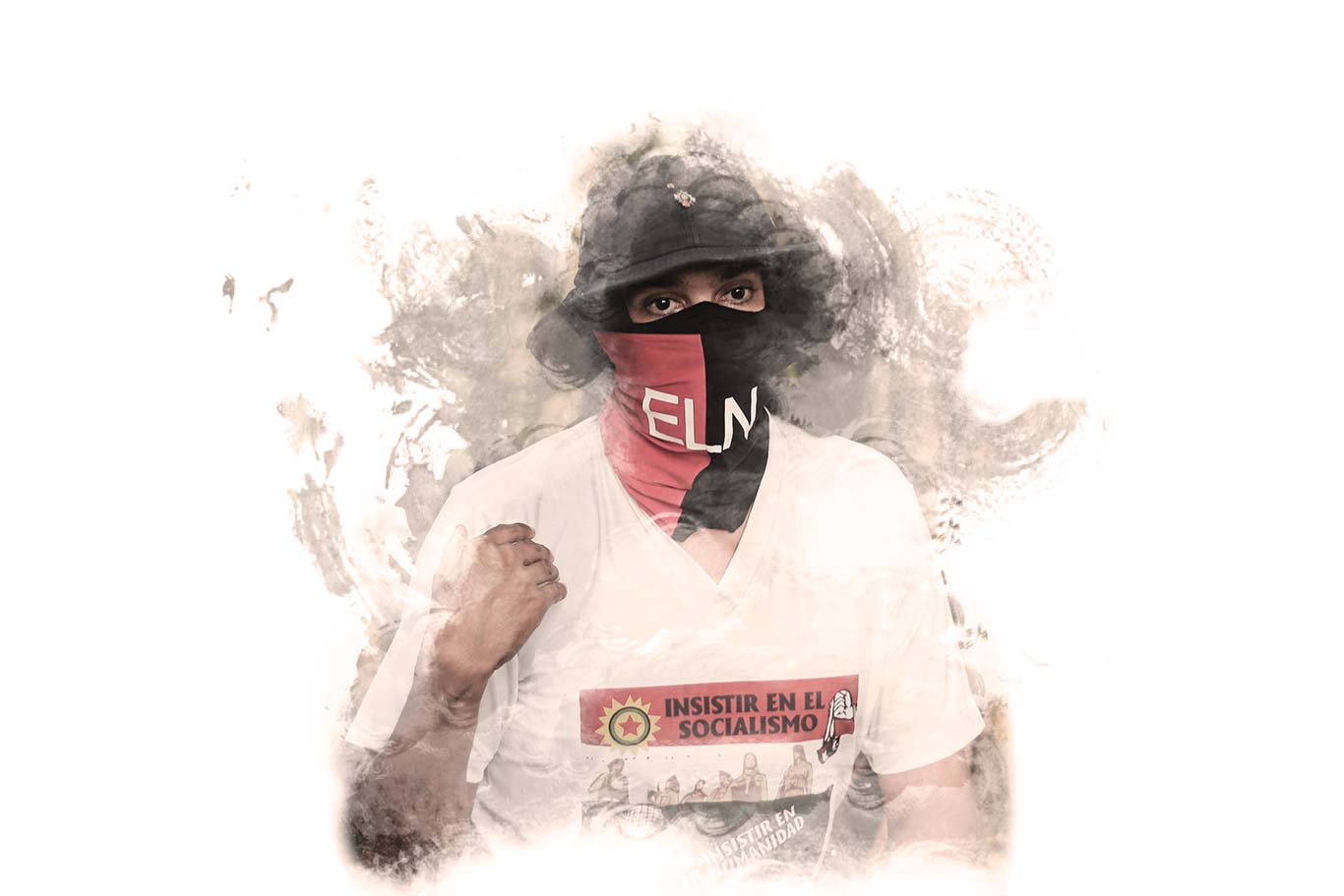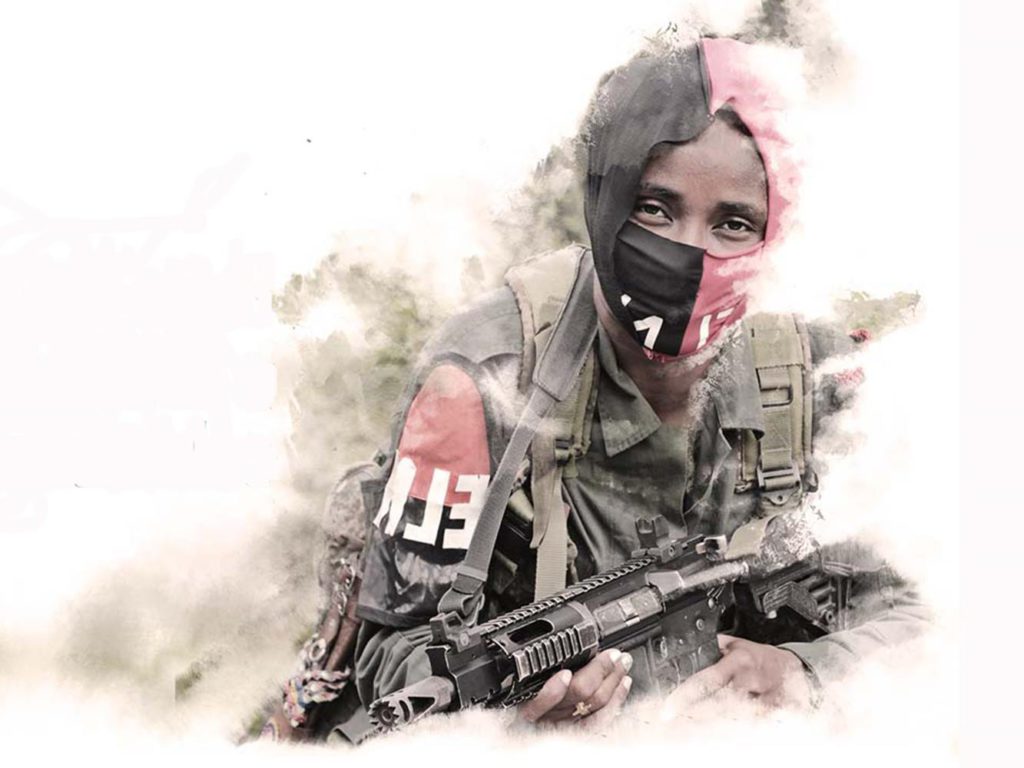“I am part of the National Liberation Army, from the Guerrilla Front Ernesto Guevara”. That is how Yesenia began her presentation. She is a tall, thin black woman, with a firm step and a big smile that reaches her eyes.
She is always accompanied by Coronel, a big white dog that was recovered from the Colombian Army. She is the first person we interview, this time with an authorized recorder and camera, in the guerrilla territory in the department of Chocó.
Yesenia is an uncommon name in the guerrilla, but a little bit of searching led me to “La Negra Yesenia” (The Black Yesenia), one of the commanders of the most important War Front in the history of the ELN. She died in combat at the end of 2011. It is common to pay homage when its time to chose aliases as “Elenos” – what members of the ELN are called.
Yesenia explains that she entered the guerrilla at the beginning of her youth, today she seems to be around 35 years old. In the beginning, what motivated her was the beauty of the group, that they all walked together with their weapons and uniforms. She didn’t give more details. “That was what happened”.
Little by little, she tells, that she began learning the ideology, the values and the “many motives that made us continue in the struggle,” like social inequality that is rampant across Colombia, she explains.
About the values, she cites: “The honesty, solidarity, discipline, to be critical…All of these values we try to inculcate in all of the comrades here. It means taking care of one another”. One of the meanings of inculcate is to imbue something in the spirit of someone.
Discipline is a daily practice. They wake up at 4:45 in the morning, prepare for the conference of the troops, sing the hymn of the ELN and begin physical training. The break for breakfast is at 8:00am and then they go back to training, finishing for lunch.
After a brief break, comes the training for the use of weapons, learning to load and unload the rifle, marching movements are done for two hours. Dinner is early, while its still daylight.
In addition to the physical training, there is political education, which begins after dinner and after washing pots and pans. In class or in rounds of discussion, they converse about the history of the ELN, read news and discuss other issues. “At eight o’clock at night everyone goes to sleep, until the next day,” describes Yesenia.
Outside the routine maintained by the whole troop, there are groups that take turns with the safekeeping of the camps, during the day and at night. Everything is timed and well defined. The tasks are also equally divided, like those in the field, kitchen and cleaning.

The work in this territory is not only internal. The guerrilleros also contribute with the communities, “by addressing the most basic needs in the region. Helping people carry-out community work, so that the community works together, and we work with them,” Yesenia explains. Whether it be building houses, creating spaces of cohabitation and general care, like the devotion to fulfill the general rules established by the community members themselves.
Like Yesenia, the guerrillera Yadira –who also has an easy and light smile, mixed with a firm and serious posture -, tells us about the actions of the ELN with the local population. “It is very good to help the communities with work, with the day-to-day things”.
Yadira is proud of carrying out special work with the women, so that “they get out of their submissive life, the ones where they have to dedicate themselves to their husbands, do what the man says”. Although feminism is not a question that is present in this guerrilla front, Yesenia says: “Here we say that we are an organization of equality”.
This is not the image that is shown of the ELN in the Colombian media or internationally. I asked Yadira about this. “The news says a lot of things, many things are not like this. For example ‘the mistreatment of peasants, displaced communities’. These are lies. When someone arrives [to a community], they identify themselves, they speak with them. No one forces anyone to do anything they do not want to do,” she explains, with a mix of sadness and discomfort in her voice.
Personalities
In one of the houses on stilts that we passed, a mother holds her baby. Without a military uniform, she wears a strapless dress. The afternoon was hot and humid. The baby around six months old, was wearing just a diaper and a red ribbon around its wrist.
One of the people on our trip, Cynthia, asked about the ribbon. “Protection,” responded the mother. Marxism, that marks the tradition of the ELN, is mixed with personal and religious beliefs. It is not surprising. In the tradition of the guerrilla there are emblematic figures like Father Camilo Torres Restrepo and Father Manuel Pérez Martínez, the Priest Pérez.
There is also space for individual expressions. Although the military wardrobe is the uniform and the symbols of the ELN are used to show their collective identity and mística, each person uses accessories that shows the way in which they identify with their beauty and vanity. The young women have braids, and they use adorned clips and bows in their hair. The young men had a variety of haircuts and berets.
In addition to the accessories that beautify them, Yadira explained to us what she carries during the treks. “I have my rifle, my vest, my handgun, my equipment – my bag, blanket, hammock, tent. These are the basic things that a guerrillero carries.”
On the guns, pistols and knives, there are also adornments and embroideries that decorate them. In a landscape marked by green, brown and black, the rest of the colors only appear in the details.

In the realm of personalities, we ask Yadira how loving relationships are built within the guerrilla. For this too, there are rules.
“Here if someone wants to get married, they get engaged. These two people then have three months to see if they stay together or if they separate. If they last these three months, they speak with the comrades and they make the marriage official. With three years of stability, they are allowed to have kids, if the marriage is stable.”
Away from the cameras, in conversations during the long walks and food breaks, others tell us about the kids of the guerrilleros and their relationships with the guerrilla, their worries. One of those is education, since there is a great scarcity of schools in rural areas and the constant movement in the territories makes permanence in formal education very difficult.
The solution would be that the civil militants would be teachers in the region, who could help create schools within the camps, where they could teach the children and teenagers, but also the adults and the communities.
According to the Ombudsman Office, in the report “The Humanitarian Crisis in Chocó” from 2014, the illiteracy rate in the department where this war front operates is 20.9%, two and a half times more than the national index. In Brazil, the state with the highest rate of illiteracy is in Maranahão, with 16.7%.
Another one of the stories exchanged is about Christmas where the children of guerrilleros can spend the holidays with their parents, in a safe area in the camp. They tell us that in this encounter there are children and even adolescents, some who were distanced or held grudges with their parents because of the separation due to their dedication to the guerrilla.
The beginning of the co-fraternizing can be slightly distant, awkward, but it only takes an exciting game of football between them for the smiles and the hugs to come out. In the goodbyes, there are tears, the painful see you later or a goodbye forever to people they love.

To learn more about how the feelings of happiness and sadness affect the guerrilleros, we asked our third interviewee, Emerson Valírio Martínez, “proudly ‘eleno’, with a red and black identification card with three white letters printed, as a symbol of peace with social justice”.
With the camera turned on, he responds to the first questions in a formal, official tone. When he is asked about the most difficult moment that he has had in the guerrilla, it seems that the memory softened up his tone.
“I was injured in combat twice. I think this was one of the hardest moments, because it was a year and a half that I was outside of the organization, in recovery, with my leg destroyed by the bullet. But, anyways, nothing is impossible that can be overcome.”
Being far from the guerrilla was what most affected him. Not only the duty to be in the struggle, but the need to be among one’s own. “I do not adapt easily to being outside of the organization, away from the [guerrilla] front, from the comrades, the family, because here we are living and working as if we were a nuclear family, where we all miss each other, as if we were brothers and sisters by blood,” Emerson shares.
And the happiest moment? “I think it was the moment where I met my baby, he is the only one I have as of now. And the other was when my family visited me for the first time. I did not have communication with them for seven years, I did not know about any of my family members. But, anyways, these are the moments that I always have as memories in my heart.”
Between two families. This seems to be the feeling surrounding Emerson, it is possibly the same one for the other youth there. How to explain to their parents or families the decision to dedicate ones own life for a cause, the one of people’s liberation?
“Well with some families or mothers, many do not agree with their children being directly part of the conflict. Without this politicization and they do not understand that it is a duty to unite and struggle for what one wants. So they always try, in some moment, [to ask], ‘why don’t you return’ and ‘there are other ways without killing’”.
The answer for Emerson is “no”, it is the path that he believes in. Between continuing “to be exploited by a boss, living in constant debt, not having anything, and living in a manner that is more precarious than in the insurgency, well [one] will want to continue risking whatever it is. And there is also the ideological conviction”.
Emerson adds: “It is generally known that poverty, the precarity of life, is what brings someone to take the decision to join an armed group”.
War zone
The Western Front – Omar Gómez is one of the nine war fronts of the National Liberation Army, that has presence across the country, including in the cities, with the Urban War Front.
Among those, they have Guerrillero Fronts, that have the objective of building people’s power in the territories. The Guerillero Front Ernesto Che Guevara was the one we visited. The group which was largely made up of youth, who wear t-shirts with revolutionary phrases and colorful patches tied on their arms.
There are also Companies, with certain autonomy in each front, the ELN has a Central Command made up of five members. The Central Command includes Nicolás Rodríguez Bautista (Gabino), who is responsible for political and military fronts; and Israel Ramírez (“Pablo Beltrán”), chief of the ELN delegation in the Peace Talks with the Colombian government.
The Western War Front has actions in Chocó, the poorest department of Colombia. Its name pays homage to Omar Darío Gómez (“Alejandro”), who was killed in combat in 2016 in this area. He had been part of the ELN for 30 years, and was the third to command this front.
Yesenia, one of the guerrilleras interviewed in Chocó, explains to us that due to the dense vegetation and the transportation system through boats and canoes, attacks from the National Army are principally aerial.
“Now the principle method is bombing from helicopters that the Army launches on us in any moment. The bombs can come during the day or at night. In this zone, they say it is very difficult to come by land and carry out an assault on the camp for example, but it is still possible. And that is why, all of the time, we are on guard. In any moment they can attack us, whether it be an aerial attack or by ground.”
With every noise of the motor boat, they look to see who is coming. An almost natural movement of every guerrillero. Their senses are always sharpened.
The enemies, in addition to the official Army of the country, are the paramilitaries that act clandestinely, as civilians, and have the support of the police and the Army. This is how the guerrilleros classify them during one of the conversations cycles that we were invited to participate in in the camp of the Guerrillero Front.
“Paramilitarism is a policy of the State to contain the insurgency. And they continue causing terror with their actions,” says one of the members of the ELN, during one of the nights of our visit. In conversation with dozens of members of the front, already in complete nocturnal darkness of the jungle, they told us about their own views of the armed conflict in the country.
The situation could seem uncomfortable or intimidating, to be among guerilleros, with their rifle straps visible on their shoulders. But being there, in that camp, gave a sensation of tranquility. It did not feel like we were in a war zone.

Why continue in arms?
The option of an armed path for the revolution is not an easy decision. In addition to abandoning civilian life, family and the home. The guerrilleros have to confront a series of daily challenges.
The structure of the camps is transitory, which is why, they do not have more than the simple constructions of the houses on stilts, no drinking water, septic tanks or even mattresses to sleep on. The domestic tools are simple. The most basic to guarantee a degree of comfort.
The deaths are not just stories. They happen. And the conviction that the struggle is greater, for the liberation of all the people, makes them continue. “And this is what makes me angry, when something happens, when they kill a comrade,” Yesenia explains.
“When they kill [us], they say ‘a guerrillero shot down,’ and when a soldier dies, ‘they assassinated a soldier.’ This is very painful. We are all sons and daughters of peasants; we are all human beings. The fact that we are armed fighting for the ideals of the poor class, does not mean that we are less than the soldiers that are fighting for the oligarchy. The soldiers that are fighting for the oligarchy are sons of the peasants just like us. So this is very painful,” the guerrillera tells us.
For Emerson, one of the leaders of the Guerrilero Front Che Guevara, what brought him to the political, social and armed conflict in Colombia that has been going on for more than 50 years, “are the same points that the Colombian State refused to discuss in the negotiations with the FARC as well as the dialogues they have been carrying out with the ELN. [The State] does not discuss the economic, political or social model, private property or the military regime”.
Without those discussions, he believes, “there will not be any changes within the policies that guide the country, and there will not be a solution that looks for social equity”.
And with the conviction and the hope that it is possible to change the reality of inequality of Colombia and Latin America, they remain in arms. “Whenever oppression exists, there will be resistance. The message for the Colombian people and of our continent is that we have to engage in struggle in different ways, join together, and together combat the oligarchy and imperialism,” Emerson states.

As the central political and military leader of the Western War Front, Commander Uriel gives us our final interview. The most visible figure of the ELN in social media, he always appears with a hat and a red and black scarf that only leaves his eyes visible. In the camp, when it’s just us, he always has his face uncovered and with gleeful gestures. For the video interview, he again covers his face.
As with other combatants, Uriel defends the armed struggle and the historical revolutionary experience, the experience of political-organizational work with the communities. In this sense, “the ELN is a patrimony not only of the Colombian people but of all Latin America.” It is not the only one. For him, there are many expressions of people’s movements in Colombia and in different countries.
“We respect the paths that other organizations, other processes decide are priority at this moment. In the ELN we are also making efforts in other areas, not only in the area of armed struggle. But we consider it necessary to maintain this seed in the armed revolutionary struggle, of the armed people’s resistance. If it is not now, it will be a priority in other moments.”
With an interpretation of process for “transforming the world and building something different,” that has as a base people’s organization and unity, he points out “imperialism will not fall on its own. Only with a strong people’s resistance will be tear it down.”
“The efforts that each one, that every organization is doing to transform the world matters, count. In the same way I hope that others value the effort that the ELN is doing to help build a different world. They say that in socialism we all enter or none of us enter. And as my t-shirt says: to fight for socialism is to fight for humanity.”
Despite that they are in the middle of the dense Chocó jungle, his intent is not to isolate the guerrilla, which is why they have started using tools of technology and communication. “Our task is not to remain quiet. Through all the possible ways we have to do agitation and propaganda, spread the revolutionary message.”
In the spirit of solidarity and fraternity, he sends a message to militants and peoples movements.
“We are here for all and we hope that many are there for us too. All are welcome. All that want to come and contribute, learn from what we can teach, and to strengthen our links. See us as an opportunity of a laboratory, of unconditional friends, of allies, of comrades in struggle.”
There is spontaneity in our daily conversations, he asks questions about the reality in Brazil, the news from other parts of the world, our opinions. Not only about politics, but other issues emerge like history, technology, tv shows and movies, and music –his preference is for rap, and he sings a song every so often.
Commander Uriel asks that we share with others the receptiveness and attention with which we were received in “eleno” territory,
A micro-sd memory chip with more information was one of the goodbye presents from Uriel and Lucía, his partner, along with colorful cloth with messages of Che Guevara, shirts and other adornments that mark the identity of the guerrilleros.
In the digital folders there were communiques, videos, photos, journalistic material and all types of files that Commander Uriel had gathered throughout the last several years.
Among other things, the songs were what made me remember how the days were with them. Different versions of the song Hasta Siempre, an homage to Che Guevara, were the most played in the moments of rest, especially the rap versions.
But the one that made me feel that I was in the jungle again, living again with those young men and women, was one that had phrases of Mario Benedetti’s poem “Man who looks at the sky.”
In the new version, they sing: “that pain doesn’t put out my rage, force, joy, life, passion. That the assassins of the people leave. We must create love and revolution again.”
I said goodbye with quick hugs. It was only a few days but they were full of intense emotions and lessons. I looked into their eyes and said goodbye, I knew I would never see them again.
During the journey on the San Juan River it seemed that I started to understand what I had seen. Looking around, with the loud noise of the motor, the wind in my ears, and a local cumbia playing on the radio, I turned around to look one last time at the houses on stilts and the faces that we passed by.
Indigenous people, Black people, children, old folks, families, in their daily activities of washing clothes, bathing and playing in the river. They returned my stare, and I had tears in my eyes. I understood what their struggle meant.
A group of yellow butterflies began to fly in circles during one of our stops. It really was the depths of Colombia.
Read the first article in the series: In the depths of the Colombian jungle: An encounter with the ELN
Brasil de Fato || Report: Vivian Fernandes || Editing: Luiza Mançano || Photos and videos: Gustavo Jorge and || Graphic Arts: Lucas Milagres and Fernando Bertolo
(English translations by Peoples Dispatch)
English Translation: Zoe PC || Editing: Prasanth R





